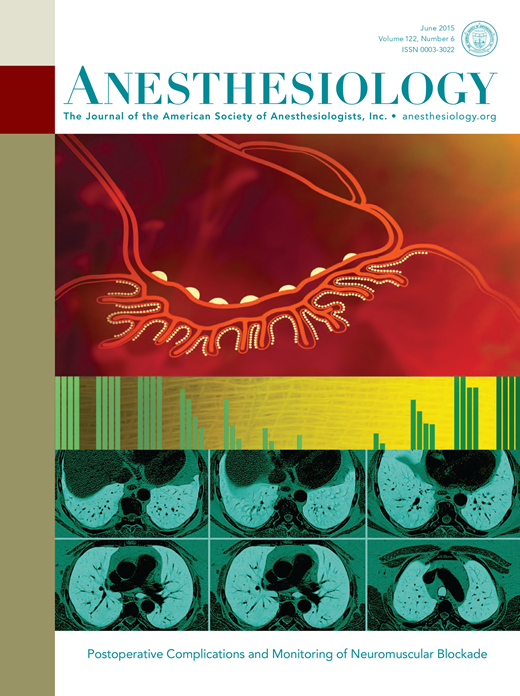Thrombin Generation in Pediatric Cardiac Surgery Patients, a Prospective Single-center Cohort Study.
IF 9.1
1区 医学
Q1 ANESTHESIOLOGY
引用次数: 0
Abstract
BACKGROUND The objective of this study was to describe thrombin generation in children undergoing cardiac surgery with cardiopulmonary bypass (CPB). Change in the endogenous thrombin potential (ETP) across three measurements before and after CPB (after protamine and at chest closure) was the primary outcome. Secondary analyses explored an association between thrombin generation and transfusion requirements and predictors of the thrombin generation decline. METHODS Blood samples of children (median age 6.3 months; 68.5% weighed <10 kg) were collected intraoperatively three times: before administration of heparin (baseline), shortly after protamine and at sternal closure. Platelet poor plasma obtained after centrifugation of these samples was frozen at -80ºC. Thrombin generation and anti-Xa assays were performed in series on batches of thawed samples to evaluate thrombin generation parameters and functional activity of unfractionated heparin which could have affected thrombin generation assay results. RESULTS Between August 2022 and May 2024, 162 plasma samples from 54 patients were collected and analyzed. Compared with baseline, mean ETP decreased by 1911 nM (95% CI 1655 to 2168) after administration of protamine, and by 1865 nM (95% CI 1609 to 2122) at sternal closure, P<0.001. Similar changes were observed in secondary thrombin generation parameters. Median unfractionated heparin activity was <0.1 U/ml at all three time points. Secondary analyses showed strong negative correlation between ETP after protamine and volume of transfusion after bypass (ρ =-0.52, P<0.001). Among five examined factors, only total heparin dose was independently associated with ETP decline, with higher dose being predictive of greater ETP decline (P=0.002). CONCLUSIONS In children undergoing cardiac surgery, we noted a significant and persistent decline in endogenous thrombin potential following cardiopulmonary bypass, despite hemostatic interventions. This reduced thrombin potential correlated with higher volume of transfusions. Additionally, greater intraoperative heparin requirements could be linked to a more pronounced decline in thrombin generation.一项前瞻性单中心队列研究--小儿心脏手术患者凝血酶生成情况
本研究的目的是描述心脏手术合并体外循环(CPB)的儿童凝血酶的产生。内源性凝血酶电位(ETP)在CPB前后(鱼精蛋白后和胸闭锁后)三次测量中的变化是主要结果。二次分析探讨了凝血酶生成与输血需求之间的关系以及凝血酶生成下降的预测因子。方法采集儿童血液样本(中位年龄6.3个月;68.5%(体重<10 kg),术中三次采集:在给予肝素(基线)之前,在鱼精蛋白后不久和胸骨关闭时。这些样品离心后获得的无血小板血浆在-80℃冷冻。在解冻样品上进行凝血酶生成和抗xa测定,以评估凝血酶生成参数和未分离肝素的功能活性,这些参数和活性可能影响凝血酶生成测定结果。结果在2022年8月至2024年5月期间,收集并分析了54例患者的162份血浆样本。与基线相比,鱼精蛋白治疗后平均ETP下降了1911 nM (95% CI 1655 ~ 2168),胸骨关闭时平均ETP下降了1865 nM (95% CI 1609 ~ 2122), P<0.001。二级凝血酶生成参数也发生了类似的变化。在所有三个时间点中位未分离肝素活性均<0.1 U/ml。二次分析显示,鱼精蛋白术后ETP与分流术后输血量呈显著负相关(ρ =-0.52, P<0.001)。在五个检测的因素中,只有总肝素剂量与ETP下降独立相关,高剂量预示ETP下降更大(P=0.002)。结论:在接受心脏手术的儿童中,我们注意到体外循环后内源性凝血酶电位显著且持续下降,尽管有止血干预。凝血酶电位的降低与输血量的增加有关。此外,术中肝素需求量的增加可能与凝血酶生成的明显下降有关。
本文章由计算机程序翻译,如有差异,请以英文原文为准。
求助全文
约1分钟内获得全文
求助全文
来源期刊

Anesthesiology
医学-麻醉学
CiteScore
10.40
自引率
5.70%
发文量
542
审稿时长
3-6 weeks
期刊介绍:
With its establishment in 1940, Anesthesiology has emerged as a prominent leader in the field of anesthesiology, encompassing perioperative, critical care, and pain medicine. As the esteemed journal of the American Society of Anesthesiologists, Anesthesiology operates independently with full editorial freedom. Its distinguished Editorial Board, comprising renowned professionals from across the globe, drives the advancement of the specialty by presenting innovative research through immediate open access to select articles and granting free access to all published articles after a six-month period. Furthermore, Anesthesiology actively promotes groundbreaking studies through an influential press release program. The journal's unwavering commitment lies in the dissemination of exemplary work that enhances clinical practice and revolutionizes the practice of medicine within our discipline.
 求助内容:
求助内容: 应助结果提醒方式:
应助结果提醒方式:


